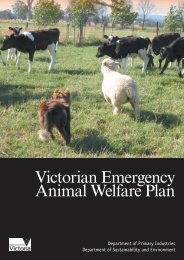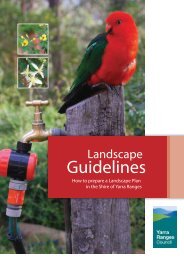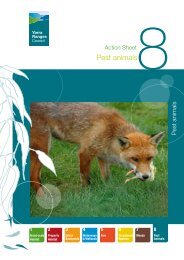Weeds 1 - Shire of Yarra Ranges
Weeds 1 - Shire of Yarra Ranges
Weeds 1 - Shire of Yarra Ranges
You also want an ePaper? Increase the reach of your titles
YUMPU automatically turns print PDFs into web optimized ePapers that Google loves.
Sweet Pittosporum<br />
Pittosporum undulatum<br />
Radiata Pine<br />
Pinus radiata<br />
Photo: D. Blair<br />
Photo: V. Freshwater<br />
Photos: E Campbell
Radiata Pine<br />
- Pinus radiata<br />
Sweet Pittosporum<br />
- Pittosporum undulatum<br />
Common Name: Radiata or Monterey Pine<br />
Scientific Name: Pinus radiata<br />
Common Name:<br />
Scientific Name:<br />
Sweet Pittosporum<br />
Pittosporum undulatum<br />
Origin: Native to North America<br />
Size: Radiata Pine is a tall evergreen, s<strong>of</strong>twood tree<br />
that can grow to 40 metres.<br />
Foliage: It has dark green needle like leaves in groups <strong>of</strong><br />
threes (rarely 2) in dense clusters along stems.<br />
Most “Christmas trees” sold fresh in the festive<br />
season are Radiata Pine.<br />
Flowers: It bears cones and does not flower.<br />
Fruit: Seed bearing cones are produced which take 2-3<br />
years to mature and last several years.<br />
How it spreads<br />
The cone opens in dry weather throughout the year and the<br />
winged seeds are dispersed by wind. They can be blown a<br />
considerable distance from the parent tree. Cockatoos also<br />
drop seed when they tear apart cones to get at the seed<br />
inside.<br />
Young Radiate Pine<br />
Photo: S. Meacher<br />
Origin: East Gippsland, Australia.<br />
Size: Sweet Pittosporum is a large bushy tree that can<br />
grow to 10m or more.<br />
Foliage: Leaves are glossy dark green and<br />
paler beneath with a distinctive<br />
wavy (undulating) edge.<br />
Flowers: Between September and<br />
December. Flowers occur in<br />
clusters and are creamy white<br />
and bell shaped, with a sweet<br />
fragrance.<br />
Fruit: The fruits are hard green capsules, turning orange<br />
when ripe. They split, to expose 20 -30 sticky<br />
orange-red seeds.<br />
Photo: SYR<br />
How it spreads<br />
This is the most wide-spread woody weed in the <strong>Shire</strong>. Its<br />
seeds are mainly spread by birds, possums and occasionally<br />
by foxes. They may be eaten and pass through the digestive<br />
system or stick to feet and feathers. They can also be<br />
transported in dumped garden waste and soil.<br />
Not to be confused with:<br />
Muttonwood (Rapanea howittiana)<br />
which has similar leaves to Sweet<br />
Pittosporum but has violet berries<br />
and small green flowers.
Wild Tobacco Tree<br />
- Solanum mauritianum<br />
Holly<br />
- Ilex aquifolium<br />
Photo: E Campbell<br />
Photo: Alex Maisey
Holly<br />
- Ilex aquifolium<br />
Common Name: Holly<br />
Scientific Name: Ilex aquifolium<br />
Origin: Native to Europe.<br />
Size: Grows slowly into a large shrub or small tree.<br />
Foliage: The stiff leaves have several sharp spikes around<br />
the edges. They are glossy dark green on top and<br />
a pale dull green beneath.<br />
Flowers: Flowers with pinkish clusters in late spring-early<br />
summer<br />
Fruit: Hard, bright red berries during autumn<br />
How it spreads<br />
Spread by birds which eat the red berries and pass the seeds.<br />
Will also germinate from berries dumped as garden waste.<br />
Seeds may take three to 12 months to germinate. When low<br />
branches touch the ground, they can take root, forming dense<br />
stands. A mature holly will produce many seeds, which will<br />
germinate around the mature tree<br />
Not to be confused with:<br />
There is a native plant called Holly Leaf Lomatia (Lomatia ilicifolia)<br />
but the leaves are quite different in appearance<br />
compared to Holly.<br />
Wild Tobacco Tree<br />
- Solanum mauritianum<br />
Common Name: Wild Tobacco Tree<br />
Scientific Name: Solanum mauritianum<br />
Origin:<br />
Size:<br />
Foliage:<br />
Flowers:<br />
Fruit:<br />
Native to South America.<br />
The plant grows very quickly into an open<br />
branched large shrub or small tree up to 4 metres<br />
tall.<br />
The leaves are highly distinctive - long (to 30cm),<br />
light green with obviously furry surface on the top<br />
and underside <strong>of</strong> the leaf. The smaller branches<br />
are also furry.<br />
The clusters <strong>of</strong> purple flowers appear throughout<br />
the year .<br />
The grape-like fruits are green at first and turn<br />
dark yellow when ripe. Fruits year-round.<br />
How it spreads<br />
The fruits <strong>of</strong> this plant are eaten by birds, bats and possums<br />
and seeds can be spread over long distances.<br />
Not to be confused with:<br />
Many Solanum species have similar star-shaped flowers with<br />
prominent yellow stamens.<br />
Note: This poisonous plant is closely related to the Nightshades.<br />
The fine hairs can irritate your eyes and throat. Wear<br />
a breathing-mask and goggles when<br />
handling.
Sycamore Maple<br />
- Acer pseudoplatanus<br />
Cootamundra Wattle<br />
- Acacia baileyana<br />
Photos: S. Meacher<br />
Photo: M. White
Cootamundra Wattle<br />
- Acacia baileyana<br />
Common Name: Cootamundra Wattle<br />
Scientific Name: Acacia baileyana<br />
Origin:<br />
Size:<br />
Foliage:<br />
Flowers:<br />
Fruit:<br />
Native to small region <strong>of</strong> southern NSW, Australia.<br />
Small, evergreen, spreading tree or large bushy<br />
shrub to 10m tall.<br />
The feathery leaves are silvery-blue-green and<br />
divided into only 3-4 pairs <strong>of</strong> pinnae, the lowest<br />
pair embracing the stem.<br />
The bright yellow fluffy flowers, carried on spikes,<br />
appear from June to September.<br />
The flattish seed pods are hard-coated, straight or<br />
slightly curved.<br />
How it spreads<br />
The seeds are spread by wind, water, cockatoos (which open<br />
the pods and drop seeds) and even ants, over short<br />
distances. The seeds survive up to many years in the soil,<br />
germinating after disturbance, especially fire.<br />
Not to be confused with:<br />
Several wattles are native to the <strong>Shire</strong>. Of those with feathery<br />
leaves the Black Wattle (A. mearnsii) has dark-green leaves,<br />
pale flowers and pods with constrictions between the seeds,<br />
while the Silver Wattle (A. dealbata) has grey-green foliage<br />
divided into 8-20 pairs <strong>of</strong> pinnae and may grow to 30m.<br />
Sycamore Maple<br />
- Acer pseudoplatanus<br />
Common Name: Sycamore Maple<br />
Scientific Name: Acer pseudoplatanus<br />
Origin: Native to Europe.<br />
Size: A fast-growing deciduous tree, up to 20m.<br />
Foliage: Has lobed dark-green leaves, light-green to purple<br />
beneath, that turn yellow before falling in autumn.<br />
The smooth grey bark becomes scaly and reddish<br />
at maturity.<br />
Flowers: Small, yellowish flowers appear in late spring.<br />
Fruit: Produces winged seeds in summer that are<br />
usually reddish and<br />
Photo: V. Freshwater<br />
are arranged in pairs,<br />
making a boomerang<br />
shape.<br />
Sycamore maple<br />
leaves and flowers<br />
How it spreads<br />
When ripe the seed pairs separate, spinning rapidly as they<br />
fall. These “helicopters” fall slowly and can travel considerable<br />
distances on the wind. Each tree can produce up to 10,000<br />
seeds every year. Wind, water, mulch and soil easily carry the<br />
seed.<br />
Not to be confused with:<br />
There are many other exotic garden<br />
varieties <strong>of</strong> Maple and Plane (Platanus<br />
spp.) trees with similar shaped leaves.

















